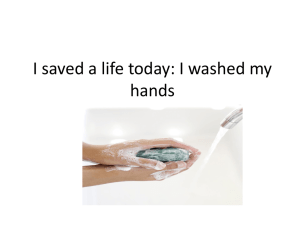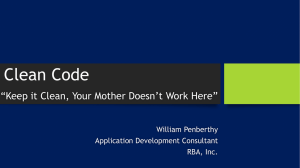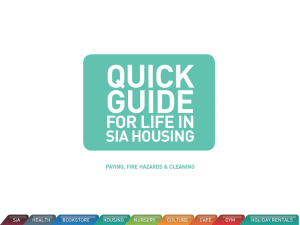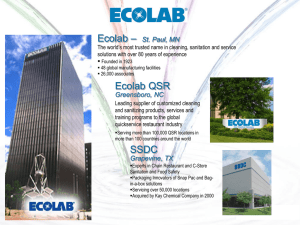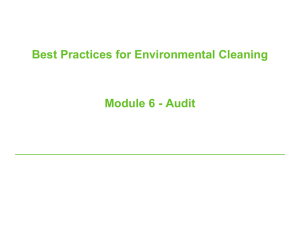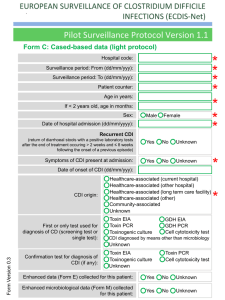Environmental Services Microsystems Team
advertisement
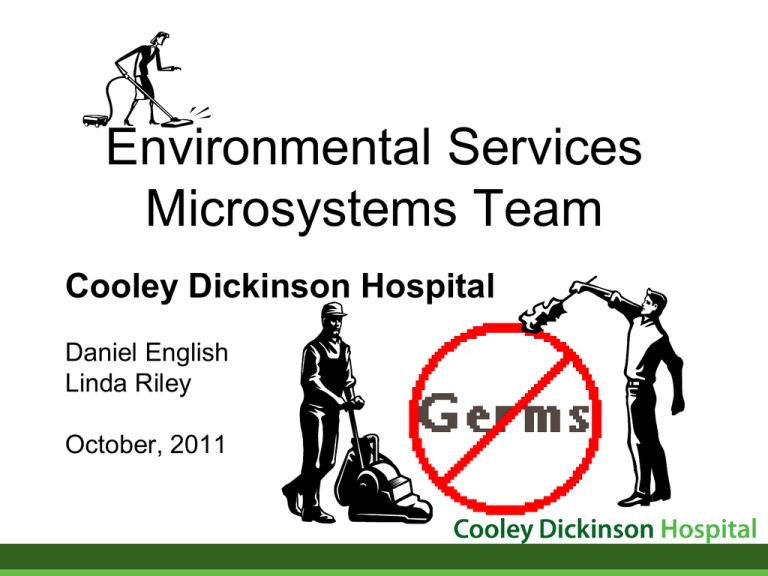
Environmental Services Microsystems Team Cooley Dickinson Hospital Daniel English Linda Riley October, 2011 Objective • On completion of this session, participants will be able to: – State 3 strategies to engage Environmental Services staff in infection prevention – List 3 interventions that will improve environmental cleanliness – Demonstrate the effectiveness of UV light in reducing CDI Hospital Associated C-Diff Rates Trendline 1.5 1.0 1.33 1.21 1.16 0.88 0.56 0.5 1.11 0.88 0.75 0.67 0.80 0.93 0.71 Q4 2010 Q3 2010 Q2 2010 Q1 2010 Q4 2009 Q3 2009 Q2 2009 Q1 2009 Q4 2008 Q3 2008 Q2 2008 0.0 Q1 2008 Rate per 1000 Patient Days C-Diff Rate One Patient’s Story • 72 yrs of age, diagnosis pneumonia, prescribed antibiotics • CDI, decreased urine output, kidney failure with hemodialysis for remainder of her life • OR for colectomy - colon removed, wears a bag • Slow recovery, CCU, on ventilator • Stroke, speech and mobility issues • Readmitted three times • Family members assist with care Causative Factors • How healthcare facilities contribute to CDI: – Insufficient hand hygiene – Insufficient environmental cleanliness – Poor antibiotic stewardship • Patient risk factors: – Advanced age and underlying illness – Certain medications – Immunosuppression Two studies highlight contamination of hospital environment with C. diff. spores as a major risk factor. Dubberke and colleagues, 2003 Shaughnessy and colleagues, 2006 • “Both studies raise the issue of contamination of the hospital environment with C. diff. spores as a - if not THE – major risk factor for nosocomial CDI. This issue deserves much greater attention than it has received in the past. Richard Ellison, MD Learned About Our Microsystems by Assessing Our 5 P Data – Patients, Professional, Purpose, Patterns, Processes • Expectations for work performance not clear to staff • Difficult to hold staff accountable • Staff received little training • Staff feels no power to improve work • Communication processes cumbersome Workflow - Fishbone MATERIALS PROCESS Unclear expectations Do not have correct equipment New approaches are needed Poor training, needs update In disrepair Communication customers unawaare Tight budget Outdated job flows Lack of a sense of accountability Communication Different levels of urgency Short staff at times Staff set in their ways Building No laundry chutes Small soiled rooms Large floor area Focus on area Lack of trust in supervisors Different skill levels Staff overwhelmed Perception of unfair workload PEOPLE Carpet hard to clean ENVIRONMENT Changes in location of depts with no notice Work areas are not defined and have no task lists or frequencies Staff Engagement • Daily Huddles • Patient stories • Making improvements, raising the level of professionalism • Invite Infection Prevention to your meetings • Data: Infections by unit, Patient survey results • Bulletin board turned into ‘Staff Feedback’ • Include EVS staff in hospital and community news letters • By getting them involved…ask for their opinion • • • • • • • • • • • • • • • • • 30+ Initiatives• Accomplished Standards and Regulations, OSHA, Fresh eyes Communication Dept aim statement Job flows Inspections Chemical Inventory reduced Confidential trash Sharps containers Instigated daily huddles ED Turnaround Seven step cleaning process Code of conduct Patient interaction scripts Reduce clutter Equipment storage Blood borne pathogens Patient room work flow • • • • • • • • • • • • • • TJC, DPH, Precaution room process C’diff room communication with Infection Prevention TB and Negative Pressure Rooms Soiled Linen bags ED Cleaning, working together Uniform switch over 2 % below budget initiative ESCt program Micro-fiber cleaning products Relocate the department Meeting room furniture Pass codes, keys and pagers Stairwell cleaning schedule Steam cleaning Improvements targeting C-diff • • • • • • • • Trained in the 9 step cleaning process ESCt room management system Increased ES staff by 2 FTEs Average turn around time from 65 to 48 Mins Education on chemical efficacy and dwell time Cleaning time from 14 mins to 24 mins Microfiber cloths/mops Restroom cleanliness, Bleach in all Bathrooms / ED / Cdiff rooms • PX-UV Light treatment Focus on the Environment PX-UV Light Xenex PX-UV Light : Taking Disinfection to the Next Level • Destroys all major classes of microorganisms that cause hospitalacquired infections. • Uses high intensity broad spectrum UV light to penetrate the cell walls, fusing their DNA, leading to instant damage and the inability to reproduce or mutate. • 99.99% of germs and spores are killed. • Goal: Flash all discharged patient rooms; Flash OR’s & ED daily. Implementation • • • • • Attention Intention What does it mean for my work? Accountability System support Challenges • • • • • • 1st Step Contract Early adopter of new technology Flow Procedure and Equipment Sustaining Change Outcomes Rate of CDH Acquired C. diff., MRSA and VRE Q1-Q3, 2006 through 2011 YTD 2.5 Rate per 1000 patient days 2 64% decrease in CDH acquired Infections 1.5 1 0.5 0 2006 2007 2008 2009 Year 2010 2011 Number of Patients with Poor Outcomes after Acquiring C. diff. at CDH 2009- June 2011 9 8 8 100% Decrease in Poor Outcomes 2011 YTD 7 6 # Patients 6 5 Deaths Colectomies 4 3 3 2 1 1 0 0 0 2009 2010 Year 2011 Thank you. Questions?

